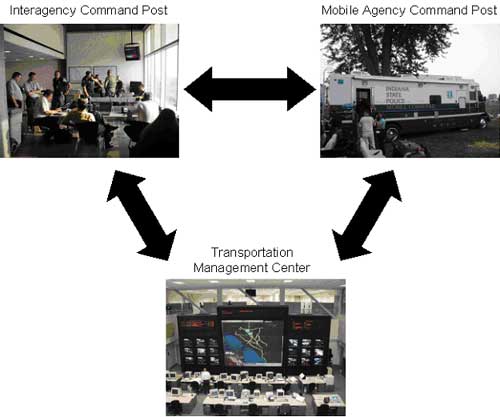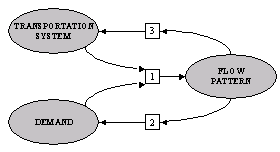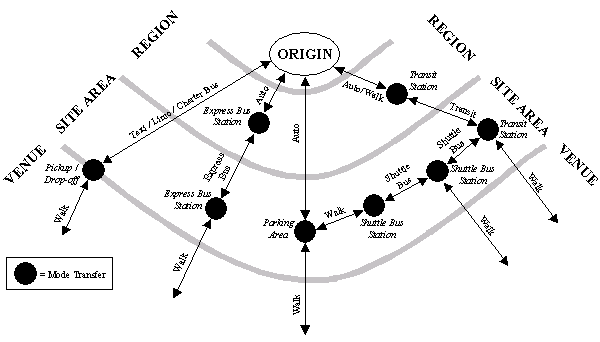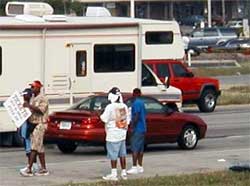
Managing Travel for Planned Special Events
Chapter Six. Traffic Management
Plan
Page 2 of 9
Plan Components 
Overview
Managing travel for planned special events involves developing a transportation management plan that contains operations and service strategies specific to managing traffic, transit, and travel demand. A transportation management plan consists of three key components:
- Traffic management plan
- Transit plan
- Travel demand management initiatives
A transportation management plan represents an extension of the feasibility study, referencing study input data and analysis conclusions, then expanding the analysis to include mitigation strategies and tactics. These strategies create a physical change in travel pattern flow, and tactics describe available tools or management approaches to meet the associated strategy.
The feasibility study results influence the scope of the transit plan and other travel demand management initiatives by identifying traffic capacity deficiencies and community (e.g., residential and commercial business) impacts. Transit agencies may work off-line to develop a transit plan detailing schedules and necessary equipment and personnel resources. The transit plan may specify one of more categories of transit operation that include:
- Existing service plus additional vehicle hours (e.g., more frequent service or expanded hours of operation)
- Existing service plus route deviation (e.g., includes new stop at transit station(s) near venue)
- Express service (e.g., new route and schedule)
- Charter service (e.g., contract service)
Numerous factors affect the category and extent of service provided. Public transit agencies must consider service boundaries and Federal Transit Administration regulations, particularly with regard to charter service. Profitability and resource availability, particularly if the planned special event occurs during a commute or high-recreational traffic period, governs decision-making as well. A traffic management plan incorporates the transit plan by accommodating proposed services and/or mitigating service deficiencies. It also promotes special travel demand management strategies, such as designating parking in preferred locations for high occupancy vehicles only.
A traffic management plan includes operations strategies for managing event-generated and background traffic within the local and regional area impacted. The plan also specifies techniques to facilitate site access, parking, and pedestrian access. Table 6-1 lists objectives of a planned special event traffic management plan. Pedestrian accommodation involves handling pedestrians arriving to a planned special event venue via all available modes of travel. To ensure the dissemination of credible traveler information, the event planning team should include media representatives and partnerships developed if necessary. The traffic management plan should include mechanisms for dissemination of accurate and up-to-date information. The plan should state expected transportation conditions, categorized by mode of travel (e.g., expected travel time by car, transit, express/charter service, etc.), with congestion mitigation measures. Safety provisions include prevention of secondary traffic incidents, reduced driver confusion, and reduced vehicular and pedestrian conflicts.
As shown in Table 6-2, the key components of a traffic management plan for planned special events include:
- Site access and parking plan
- Pedestrian access plan
- Traffic flow plan
- Traffic control plan
- En-route traveler information plan
- Traffic surveillance plan
- Traffic incident management and safety plan
Not all plan components represent a distinct formal plan but warrant consideration, either individually or in concert with another component. For instance, a traffic incident management (TIM) plan may reference an existing TIM manual for a region but include new operations details (e.g., freeway service patrol routes and quick clearance strategies) specific to the planned special event.
The event planning team in-charge of developing the traffic management plan also should consider the number and operating characteristics of traffic management team command centers to be used on the day-of-event. Figure 6-2 shows three command center arrangements for traffic management team operations on the day-of-event. Stakeholders may utilize one to all command center types during the day-of-event. The tactical approach presented in the traffic management plan depends on what command centers are planned. A transportation management center (TMC) allows for the automation of several traffic surveillance and control tasks. Agencies dispatching a mobile command post on the day-of-event may take responsibility of developing a traffic management plan for the road system segment within their jurisdiction. In turn, the agency: (1) coordinates critical elements of the plan (e.g., freeway to street connections) with other pertinent stakeholders during event planning team meetings, (2) formally distributes the plan during the implementation activities phase, and (3) staffs a supervisor at an interagency command post on the day-of-event. Therefore, for a single planned special event, the traffic management plan may include one plan developed by an interagency event planning team or a series of plans specific to each affected jurisdiction or each transportation system component (e.g., freeways, streets and intersections, and venue site).

Figure 6-2. Traffic Management Team Command Centers on the Day-of-Event D
Development Process and Integration
The following principles steer the traffic management plan development process: (1) provide a satisfactory level of service to all transportation system users, and (2) achieve balanced transportation system operations. Figure 6-3 illustrates the fundamental relationships in transportation system operations that drive the consideration and evaluation of mitigation measures throughout this process. Characteristics of demand include volume, route of travel, and mode of travel. Transportation system characteristics include:
- Existing infrastructure (e.g., number of travel lanes, parallel roadways, etc.)
- Operational policies and regulations (e.g., scheduled transit service, traffic signal control, etc.)
- Monetary costs (e.g., parking fees, tolls, etc.)

Figure 6-3. Fundamental Relationships in Transportation System Operations
In Chapter 5, the feasibility study evaluated the flow pattern created by the transportation system and demand (relationship #1). The traffic management plan development process begins with an assessment of this flow pattern. First, practitioners should recognize that flow pattern influences travel choice and, therefore, demand (relationship #2) as long as other attractive (e.g., higher utility) travel alternatives exist. For instance, a feasibility study may identify a roadway capacity deficiency, but an effective traveler information plan can alleviate the deficiency by informing transportation system users of other, underutilized travel alternatives (e.g., alternate routes or modes). This effort achieves balanced transportation system operations by equalizing the utility of all available travel choices and may succeed in providing a satisfactory level of service for all system users.
Flow pattern also influences the transportation system (relationship #3), causing planners to implement capacity improvements or changes in transportation system operations. Simple changes include establishing temporary regulations or revising monetary charges (recouped from event organizers) to influence travel choice utility. Other infrastructure and operations mitigation measures required to manage travel for a planned special event are developed by the event planning team and specified in the traffic management plan. Such measures, when analyzed or implemented, cause a flow pattern change.
The most cost-effective and preferred set of strategies for planned special event travel management utilizes the existing transportation system infrastructure and services. This represents the recommended initial focus of the event planning team; Achieve balanced transportation system operations, then evaluate system level of service.
Planned Special Event Activity Networks
Figure 6-4 outlines the various activity networks that may serve a planned special event venue. Each activity network describes the inter-modal movements and transfer points from origin to venue destination. Integration of the traffic management plan components involves meeting the service requirements of these activity networks. For example:
- A pedestrian access plan must accommodate pedestrian trips connecting various modes of travel.
- A courtesy shuttle bus operation may service both public transit stations and satellite parking areas within the venue site area.
- Traveler information plans must account for all activity networks.
- Impacts to non-attendee transportation system users occur on the regional level, and activity network components within the site area level impact local residents and businesses near the venue.

Figure 6-4. Planned Special Event Activity Networks D
For smaller planned special events, the event planning team may target one activity network, such as improving automobile access to designated parking areas or improving public transit usage. For larger events, the team must coordinate and achieve seamless operation among several activity networks.
Special Considerations
The event planning team must create a flexible traffic management plan that accommodates modifications on the day-of-the-event as well as special considerations that surface prior to the planned special event.
Table 6-3 lists the various groups that either attend or have a direct interest in a planned special event. Throughout the traffic management plan development process, the event planning team must regularly monitor and communicate any special considerations that arise in conjunction with the needs of the groups attending the event.
| Group |
|---|
|
Dignitaries
Ensuring the security of dignitaries traveling to and from an event venue requires added traffic control measures and constant surveillance while a motorcade is in motion. This includes the implementation of a rolling roadblock as the motorcade traverses a planned route in addition to the use of aerial surveillance for monitoring motorcade progress and downstream traffic conditions. In fact, the transport of dignitaries represents a planned special event in itself, regardless of travel purpose. Dignitaries may not announce a visit until the last minute, well after the event planning team finalizes the event traffic management plan. Also, non-security personnel, including transportation agency officials, may not receive information on the actual dignitary arrival time or motorcade travel route until a short time before the motorcade commences travel. In turn, the event planning team must maintain special provisions within the traffic management plan, such as alternate road closures based on motorcade route, to allow a motorcade unimpeded access to its destination.
Event Participants
Event participants not only require secure transport, but maintaining their travel itinerary is of critical importance. In particular, regional/multi-venue events may require event participant transport while ingress/egress operations take place at adjacent planned special event venues. Here, stakeholders may elect to outfit vehicles used to transport participants with an Automatic Vehicle Location (AVL) system. The traffic management team can continually monitor the exact location of vehicles transporting participants and other VIPs from a TMC or command post and implement special traffic control (e.g., change traffic signals to a green indication) as needed.
Media
Media often arrives to a planned special event well before spectators and marks one of the last groups to depart the event. However, media crews may conduct broadcasts outside the event venue. Coverage of a street use event involves special accommodations as well. The event planning team should coordinate with media groups on where: (1) media trucks will park, (2) cameras positioned, and (3) cables run.
Street Vendors
Under normal day-to-day traffic operations, side friction generally refers to the frequency of parking maneuvers and transit stops occurring in and out of travel lanes. Street vendor activities during planned special events, shown for example in Figure 6-5, impede traffic flow as event patrons slow or stop to conduct transactions (e.g., buy event tickets or merchandise). Motorist safety becomes a concern when street vendors traverse the right-of-way of freeways and arterial roads. Elements of a traffic incident management and safety plan should include tactics for eliminating illegal street vendor activities.

Figure 6-5. Street Vendor Activity
Contingency Planning
Contingency planning represents event insurance. While stakeholders may consume additional time and resources during advance planning for a planned special event, the availability of contingency plans helps mitigate a potential systemic breakdown of the transportation system during an unexpected event occurring at or near the same time as the planned special event. Key steps in contingency planning include:
- Develop a traffic management plan that is scenario-based. This concept applies to various plan components as well as to pertinent tactics. Each developed plan should include response actions for different unplanned scenarios. Plans and tactics may consider identical and different scenarios. A response action under one plan may warrant implementation of a contingency response described in another plan. For example, heavy rains that force the closure of a parking area triggers traveler information message changes to an alternate planned set.
- Consider and plan for a range of possible unplanned scenarios. Table 6-4 provides a contingency plan checklist for planned special events. This checklist includes the risk scenarios presented in the previous chapter. An emergency management agency may maintain a separate emergency response plan that, if put into effect, supercedes the traffic management plan. Yet, the emergency management agency and other public safety agencies work as part of the event planning team to ensure adequate emergency access routes, pedestrian access routes, and evacuation destination areas exist to meet emergency management plan requirements.
- Determine changes in operation due to unplanned scenarios. Aside from evacuation, the occurrence of a major traffic incident or security threat creates a multi-faceted problem for a traffic management team. This includes potential reallocation of personnel, from field crews to supervisors who must manage the unexpected event, and equipment resources. In addition, intra- and interagency radio communications may become deficient in servicing the unplanned event and planned special event if agencies failed to assign a dedicated channel for planned special event only communications.
Consider the level of response to a security threat, involving a suspicious truck stopped on a freeway, that occurred during the 2002 Winter Olympics:(1)
Early in the Games, a semi-trailer truck was stopped on the I-15 freeway, just south of downtown Salt Lake City. Because the truck did not have the legally required markings and other reasons, the Utah Highway Patrol (UHP) considered the situation to be a potential safety threat. Additional law-enforcement resources were summoned to the scene. During the entire time, the staff in transportation management center Room 230 (regional transportation management stakeholders) monitored the situation closely, viewing it with a nearby CCTV camera as well as monitoring radio reports from the UHP officers at the scene. After almost an hour passed without a resolution, staff in Room 125 (senior Utah DOT traffic engineers) began preparing to invoke the contingency plan for closing the freeway in both directions. This Action Set would have diverted all freeway traffic to parallel arterials, with the appropriate traffic management actions (new signal timing on the surface streets, changeable message sign messages on the freeway), plus traveler information actions (issuing a CommuterLink Alert, media bulletin, etc.). Fortunately, it was soon determined that the cargo in the truck was benign and the "issue" was closed in Room 230.
Planned Special Events Traffic Management | Privacy Policy